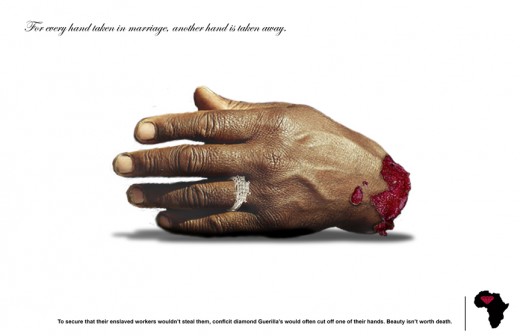Insurgency, Terrorism & Illicit Finance: Laundering Blood Diamonds


War costs money. This is true for insurgents as well; it is used to acquire military supplies, pay salaries, and covering a plethora of other operational expenses[i]. Insurgencies, which often utilize terrorist tactics, require a number of factors to be in place to be successful. Among them is third party sponsorship such as Iranian-backed Shiite militants that hacked into predator drones or independent funding. Local resources determine what assets are available to people who want to turn them into money for their operations. In Western Africa, this source of revenue is commonly diamonds. There are “conflict countries” where people are pressed into service to mine raw diamonds. These precious stones have been referred to as “blood diamonds” due to the cost in human life that they wreak on the local population. Upon being introduced to the black market, these unfinished gems retain their value but must first be laundered before they can be allowed to resurface in the open market where they can be sold for cash and thereafter more easily traced. Due to their high ratio of universal value to density, and their availability to warlords who can easily use them in lieu of currency, blood diamonds used to fund illicit activity including but not limited to insurgency and terrorism pose a significant challenge to Global Anti-Money Laundering Agencies as they widely accepted as currency, hard to trace and, in spite of countermeasures, easy to launder.
The World Wide Web that makes communications between countries so easy also makes illicit finance more risky in some ways and more convenient in others. Ill-gotten gains can’t be deposited into a bank account in large amounts without attracting attention; money laundering offers criminals a way around this issue. Large sums of money that will attract attention will definitely be traced, specifically anything over $10,000 United States Dollars (USD) is required t o be reported to the IRS.[ii] So the first step to illicit financial activity such as money laundering is to leave the electronic domain and operate in the physical world. Here in the physical world, there is less automated oversight tracking a person’s every move and every transaction. On top of that, arrangements can be made for goods and services and not just dollar for dollar. For example if one were to purchase a souvenir such as gold medallions from the gold dispensing kiosks recently fielded in Abu Dhabi, aside from the funds coming from their account, there is no “paper trail” and the portable piece of gold retains its value as well. In fact, gold is among the “near cash” items such as jewelry and gemstones that the United Arab Emirates admits needing to regulate better[iii]. Each ten-gram bar is worth at a minimum its “weight in gold”—not to mention the collectable aspect—for the sake of the example; as this is being written, the international gold exchange rate is $1197.20 USD per ounce[iv]. At this rate, a pound of gold is worth $19155.20 USD. Depositing this amount into a bank account would raise flags and be tracked by automated systems and it would be monitored by the authorities. By converting this to a hard asset, there is now no record of its existence it can be placed in a safe deposit box somewhere that the government is unlikely to look. Breaking it down into multiple assets of smaller value makes it more difficult to track the original amount since they have no requirement to stay together. The full set can be stored indefinitely and retain its value. While gold prices may fluctuate slightly, by comparison, any loss will be a small price to pay for the security and secrecy afforded by converting the hard currency to an untraceable asset. There is always the likelihood that its value could increase after a period of time. This was actually the intention of these gold dispensing ATMs; for people who wanted to start investing in gold[v]. So what if a lot of cash needed to be transported without attracting attention? At an airport, such a large amount of hard currency would have to be declared and customs would likely have a lot of questions if it somehow was able to avoid being confiscated. However, the biggest risk to carrying a tangible asset on your person when laundering money is losing it at the security checkpoint while going through the X-Ray machine. A money launderer and his bodyguard acting as collectors or even gold investors could easily move one pound of gold without attracting too much attention. If currency were to be distributed between them, it would be considered “structuring” which is also illegal. In this way assets that retain their cash value can be trafficked without attracting attention—or at least not too much attention. Upon arrival at a destination the gold can then be converted back into hard cash at approximately the value of the original sum. Or perhaps, at a small commission to the guaranteed buyer who will then turn around and sell it at fair market value for a profit. This could be done at a location such as a legitimate business like a jeweler or goldsmith that would be able to melt it down and make something completely different like jewelry, further complicating efforts to track the gold by the authorities. While there may be a notable loss, a large amount of money has slipped right under the noses of the people that were supposed to prevent it. In a manner of speaking, this system could be comparable to paying interest on a credit card except this is now tax free and liquid currency. Criminal organizations and entrepreneurial free agents would make a point of selling this gold, in bulk or separately as needed to protect their assets or yield a profit depending on their priorities.

The above a very rudimentary example of how things work in money laundering when using the creative media exchange method. In the real world, operations are considerably more involved and move a lot more money at any given time. Let’s take a better look at the “conflict diamond” market in western Africa. Diamonds that have real cash value are used to fund a variety of illicit activities from local insurgencies, to global terrorism. For instance, in Liberia, diamond smuggling and illegal arms trading were used to fund the Liberian Civil War and even continued after it ended on August 11, 2003.[vi]
In the example, if the money launderer had wanted to purchase something like a set of unregistered automatic weapon he could have sold the gold bars for at least $19,000 USD (they may be worth more to a collector) and given the hard currency to the weapons dealer. Another option would have been to just give the gold directly to the dealer affording him all the anonymity of having an untraceable asset and without the trouble of having to carry a large roll of cash on his person. The benefit to this transaction is that if the weapons were sold for only $18,000, then the dealer just made a $1,000 profit unless he decides to “make change” by giving the customer something of value in return or offers additional goods and services; ammunition for or delivery of the weapons, for instance. Then again, working with smaller amounts, the buyer could just use enough of the gold bars to pay off the weapons dealer and keep the rest for himself something else, like mother said, “don’t spend all your money in one place.” One will notice again, that there is no actual cash changing hands, only goods or services. Every level of exchange makes it more difficult to track things down as the value (not serialized currency) moves further away from its source. Gold can actually change forms and still retain its value regardless of its form so melting it down into fewer bars that are larger in size is possible. The dealer can now initiate the placement phase of money laundering by taking the gold to a jewelry store and selling it in small amounts over a period of time. Or if he commonly accepts jewelry or precious metals in lieu of currency, he would likely own his own jewelry store or pawn shop that can be used as a front for his own money laundering. In the case that he actually owns the jewelry store, he would likely work with a goldsmith that would be able to fashion any variety of jewelry from the gold. He would accept payment for his labor and the jewelry shop could sell the new jewelry at marked up prices for even more of a profit due to the craftsmanship. Depending on how stringent the local laws are, he can then simply trickle the proceeds into the bank or find other ways to distribute or invest it during the layering phase.

Laundered blood diamonds can also be used to fund terrorism. Al Qaeda has used these basic principles to its advantage by purchasing low-cost diamonds in “conflict countries” such as Sierra Leone and then selling them at fair market value in Europe. There are also reports of Al Qaeda purchasing diamonds at fair market value which suggests that they expected their accounts to be frozen shortly after 9/11 and were trying to secure their funds in physical assets that could not be traced. Most recently, there was a story of a man who supported by Al Qaeda by providing funds to them[vii]
In an attempt to mitigate the prevalence of these diamonds in the black market, the United Nations has developed the Kimberley Process. A Kimberley Process certificate must be attached to diamond shipments certifying that each shipment of rough diamonds leaving a country is in a tamper-proof container and shipped to another Kimberley Process country[viii]. While this does make things a little more difficult for the criminals involved, by necessity, successful entrepreneurs in the black market are generally a step ahead of authorities. As a result, there have been forged or otherwise illegitimate Kimberley certificates. Diamonds are mined in conflict countries such as Liberia and then smuggled out under false certificates claiming that they originate from Kimberley countries[ix]. While the key trade bodies representing the global diamond industry agreed to a voluntary system of self-regulation intended to help prevent the trade in blood diamonds and in supporting the government-run Kimberley Process Certification system, the polishing and retail sectors of the diamond industry opposed stringent government regulation when the Kimberley Process was being negotiated. Because of this, these sectors were left to police themselves[x]. Once the diamonds are cut and polished, their geology is less discernable leaving no way to be certain what their country of origin is. As a result, diamonds themselves are laundered in much the same way money is laundered and they sold on the open market as “conflict free” gems[xi].
So, to sum things up, since they are able to retain their value, blood diamonds can be used in place of currency to fund illicit activities affiliated with insurgency and terrorism. When involved in money laundering, blood diamonds themselves must first be laundered with illegitimate Kimberley Process certificates to cloak their origins allowing them to reach the open market and be sold for their fair market value. Unfinished diamonds can also be sold directly to unscrupulous diamond dealers without any certification process[xii] and then smuggled out of country and incorporated into batches that are legitimately certified under the Kimberly Process. Once cutting and polishing are complete, these illicit diamonds become untraceable. For this reason, putting controls in place may make it more difficult for the conflict diamond trade and money laundering to continue, however, it falls short of making it impossible. The only way to stop it from happening seems to be stopping the perpetrators rather than creating obstacles for their process. The problem is that removing one person from the equation, only leaves a void to be filled by someone else. This makes countering illicit finance more challenging to the anti-money laundering agencies. Before any reasonable progress can be made, the severity of legal ramifications needs to be increased so that the ratio of risk to gain will be unfavorable to those who profit from the conflict diamond trade. Furthermore, a longer term of incarceration prevents experienced players from returning to the trade after their sentence is complete. Corruption among those who would enforce these changes must also be eliminated before any progress can be made; and that’s another topic entirely.

NOTES
[i] O'Neill, Bard E. Insurgency & Terrorism. Washington DC: Patomac Books, 2005 p. 145.
[ii] Comptroller of the Currency Administrator of National Banks. "Comptroller’s Handbook." Bank Secrecy Act/Anti-Money Laundering. Washington, D.C.: Department of the Treasury, December 2000.
[iii] Professionaljeweler.com. Diamond Trade Still Vulnerable to Money Laundering, Says U.S. Report . March 08, 2004.
[iv] KITCO. Charts & Data. May 25, 2010. http://www.kitco.com/charts/livegold.html (accessed May 25, 2010).
[v]Smith, Iain. Abu Dhabi ATM swaps cash for gold. May 13, 2010. http://news.bbc.co.uk/2/hi/8679876.stm?ls (accessed May 13, 2010).
[vi] Professionaljeweler.com. Diamond Trade Still Vulnerable to Money Laundering, Says U.S. Report . March 08, 2004.
[vii] Frieden, Terry. U.S. citizen pleads guilty to sending funds to al Qaeda. May 19, 2010. http://www.cnn.com/2010/CRIME/05/19/missouri.al.qaeda.funding.plea/index.html?eref=igoogle_cnn (accessed May 19, 2010).
[viii] ConflictDiamonds.org. Conflict Diamonds in Sierra Leone. April 20, 2010. http://www.conflictdiamonds.org/ (accessed April 20, 2010).
[ix] Professionaljeweler.com. Diamond Trade Still Vulnerable to Money Laundering, Says U.S. Report . March 08, 2004.
[x] The Naked Truth. Combating Blood Diamonds – The Diamond Industry’s Failure. March 12, 2008. http://nakdtruth.wordpress.com/2008/03/12/combating-blood-diamonds-the-diamond-industrys-failure/ (accessed April 15, 2010).
[xi] Professionaljeweler.com. Diamond Trade Still Vulnerable to Money Laundering, Says U.S. Report . March 08, 2004.
[xii] Professionaljeweler.com. Diamond Trade Still Vulnerable to Money Laundering, Says U.S. Report . March 08, 2004.
Bibliography
American Atheists. Televantelist's pal Charles Taylor again linked to al Qaeda money laundering, ‘conflict diamonds’. December 31, 2002. http://www.hartford-hwp.com/archives/27d/025.html (accessed April 20, 2010).
Comptroller of the Currency Administrator of National Banks. "Comptroller’s Handbook." Bank Secrecy Act/Anti-Money Laundering. Washington, D.C.: Department of the Treasury, December 2000.
ConflictDiamonds.org. Conflict Diamonds in Sierra Leone. April 20, 2010. http://www.conflictdiamonds.org/ (accessed April 20, 2010).
Emerson, Steven. Blood Money: Hezbollah's revenue stream flows through the Americas. March 01, 2007. http://www.steveemerson.com/4281/blood-money-hezbollahs-revenue-stream-flows (accessed April 15, 2010).
Farah, Douglas. Al Qaeda Cash Tied to Diamond Trade. November 02, 2001. http://www.globalpolicy.org/component/content/article/182/33794.html (accessed April 17, 2010).
Frieden, Terry. U.S. citizen pleads guilty to sending funds to al Qaeda. May 19, 2010. http://www.cnn.com/2010/CRIME/05/19/missouri.al.qaeda.funding.plea/index.html?eref=igoogle_cnn (accessed May 19, 2010).
KITCO. Charts & Data. May 25, 2010. http://www.kitco.com/charts/livegold.html (accessed May 25, 2010).
O'Neill, Bard E. Insurgency & Terrorism: From Revolution to Apocalypse. Washington DC:
Patomac Books, 2005.
PJM. Diamond Trade Still Vulnerable to Money Laundering, Says U.S. Report . March 08, 2004. http://www.professionaljeweler.com/archives/news/2004/030804story.html (accessed April 15, 2010).
Professionaljeweler.com. Diamond Trade Still Vulnerable to Money Laundering, Says U.S. Report . March 08, 2004. http://www.professionaljeweler.com/archives/news/2004/030804story.html (accessed May 10, 2010).
Smith, Iain. Abu Dhabi ATM swaps cash for gold. May 13, 2010. http://news.bbc.co.uk/2/hi/8679876.stm?ls (accessed May 13, 2010).
The Naked Truth. Combating Blood Diamonds – The Diamond Industry’s Failure. March 12, 2008. http://nakdtruth.wordpress.com/2008/03/12/combating-blood-diamonds-the-diamond-industrys-failure/ (accessed April 15, 2010).
Zalman, Amy Ph.D. Five Myths about Al Qaeda Terrorist Financing & Money Laundering. January 01, 2009. http://terrorism.about.com/od/globalwaronterror/tp/Al_Qaeda_Financing_Myths.htm (accessed
April 20, 2010).








